With regards to measuring upper body strength, the bench press is the king of the push exercises. An enormous bench press means big muscles, including giant pecs, sculpted shoulders, and horseshoe triceps. Not only is it essentially the most common lift to measure your strength, but it surely’s also a source of pride for any lifter.
The bench press will be difficult when breaking through plateaus and constructing chest strength. Just lying down and attempting to throw some weight around with no plan is not going to chop it. It takes intelligent programming, appropriate assistance exercises, and understanding some crucial principles.
Table of Contents:
- What Is The Bench Press?
- What Is A Bench Press Program, And Why Do You Need It?
- How To Increase Your Bench Press
- The Best Bench Press Program For Strength
- 9 Best Exercises For A Bench Press Program
- Muscles Worked In A Bench Press Program
- Advantages Of A Stronger Bench Press
- Programming Suggestions For Improving Your Bench Press
- FAQs
What Is The Bench Press?
The flat bench press is a compound horizontal pressing exercise. It’s performed by lying on a bench, lowering a bar (with weight) right down to your chest, after which pressing it back up. This will be done with different variations and equipment, however the barbell bench press will construct essentially the most strength for a one-rep max and interact essentially the most muscle mass to your upper body.
Due to what number of muscles it targets, the bench press is one of the crucial popular lifts for bodybuilding. Together with the deadlift and squat, it’s one in every of the large three exercises performed in powerlifting competitions.
What Is A Bench Press Program & Why Do You Need It?
If you’ve gotten already enjoyed the beginner gains portion of your lifting profession, you likely have experienced frustrating plateaus in your strength. With regards to your bench press training, a bench press program will assist you to break through to latest personal records.
A bench press program is a more sophisticated approach that offers you a strategic plan of attack to extend your one rep max and construct your chest strength. A program can be for a selected time, commonly between 8-16 weeks.
During this time, this system will progressively overload your muscles by increasing either weight or reps each week. This principle is vital because to grow and construct strength, you should increase the training stimulus in a controlled fashion from week to week.
A great program will goal your weak points, and in today’s case, it’s going to provide the suitable assistance exercises that can help strengthen the underside portion of your bench press. This implies you’ll construct stronger chest muscles to assist you to explode out of essentially the most difficult portion of the lift, the underside.
If everyone could go to the gym and add 5 kilos every week eternally, we might see everyone benching over 1000 kilos. But this is not the case. Using a bench press program gives you a road map to putting up big bench press numbers you’ve gotten never done before. As we said, the strength gains can be harder to return by after you have been lifting for an excellent period.
How To Increase Your Bench Press
Listed below are some training suggestions and ways to structure your program to make sure you add weight on the bar.
1) Progressive Overload:
Progressive overload is crucial for improving muscular strength in any exercise, and the bench press isn’t any exception. You’ll be able to overload by increasing weight, reps or sets, range of motion, and time under tension. This implies regularly increasing the stimulus and stress you place your muscles under.
Doing higher reps within the 15-20 range could also be great for chasing the pump, but it surely won’t be as helpful for constructing strength, so save this for the tip of your workout after your heavy training. For essentially the most part, you’ll be wanting to live within the 3-8 rep range for this task. Most of your sets needs to be done at 80% of your one rep max or higher.
A correct bench press program will lay out your sets, reps, and goal weights over the required period. That can ensure you might be progressively overloading weekly with the tip goal in mind.
2) Prioritize Heavy Compound Lifts:
Constructing and sculpting muscle is great, but when you must increase your bench press and chest strength, compound lifts, just like the bench press and standing shoulder press, need more priority than chest machines and pec flies.
These assistance or isolation exercises should follow the compound lifts like a bench press. Bench presses work essentially the most upper body muscles and construct essentially the most strength, so that they need the majority of your focus and energy at the beginning of your workout.
3) Pick Appropriate Assistance Exercises:
After you finish your pressing portion of the workout, it’s crucial to hit your weak points with assistance exercises. Assistance exercises are supposed to help construct strength for a compound exercise.
For a bench press, the weak points would either be at the highest of the lift in the course of the lockout portion or the underside of the lift as you push the bar off your chest. Picking the right assistance exercises to assist that weak point of the lift will ensure your chest is powerful enough to power through that sticking point and help increase your one rep max.
3) Develop The Chest As A Whole:
In the event you only perform a flat bench press, you’ll miss out on developing the upper chest. We’re talking about constructing your entire chest’s strength, so you don’t need to exclude a portion of the chest muscles after they may very well be helping out. Sometimes, this in itself can increase your bench one rep max.
4) Bench Press More Often:
The bench press is a skill you have to practice similar to a golf swing, and you may also progressively overload that. The more you bench press, the higher your form and the more practical your movement. Assistance exercises will help increase your bench, but they may never replace the lift. In the event you don’t train the movement, it’s like attempting to grow to be higher at violin by playing the guitar.
5) Improve Your Bench Press Form:
To extend the effectiveness of your bench press, you have to improve your form. A number of quick suggestions are to bring your chest to the bar, screw your feet into the ground, and break the bar in half. This may enhance the force transfer out of your muscles to the bar and help move the bar within the shortest, simplest distance. Proper form also prevents injuries that decelerate your progress.
6) Fewer Reps, More Rest:
You have to more rest to get well between sets when performing reps in the ability/strength rep range. Resting 2-3 minutes between sets is an incredible start, and once you might be considered a complicated lifter, you could need as many as 5 minutes between sets.
Consider your energy as a progress bar that depletes after you finish your set. Waiting longer will fill it back as much as make you stronger. Your entire workout doesn’t should go like this, but it surely’s the fitting move for compound exercises like a bench press.
7) Be Patient and Manage Expectations:
In the event you try to interrupt through a bench press plateau, you should leave your ego at home. If a program calls for 16 weeks of progression, you have to accept that you could not see a substantial increase in strength as fast as you want.
Essentially the most common mistake people make is ditching their program too early because they’re frustrated. Give it time to work and accept that even a 5-pound increase is big progress.

The Best Bench Press Program
This program goes to be built around two upper body pressing days inside your training week. Every day could have the identical bench press programming but barely different assistance exercises.
It’ll require you to know or discover your one rep max bench so you need to use the indicated percentages to learn what weight to make use of. In the event you need assistance with determining your 1RM, enlist the assistance of a licensed personal trainer or perhaps a knowledgeable gym buddy. Over eight weeks, the sets, reps, and percentages will change. Be certain that to have at the very least two days between these workouts for ample muscle recovery.
Use this to your bench press sets and reps scheme throughout this system:
|
Week |
Sets x Reps |
% of 1RM |
|
1 |
3 x 12 |
65% |
|
2 |
3 x 10 |
70% |
|
3 |
3 x 8 |
75% |
|
4 |
3 x 6 |
80% |
|
5 |
3 x 5 |
85% |
|
6 |
3 x 3 |
90% |
|
7 |
3 x 1 |
92.5% |
|
8 |
2 x 1 |
95% |
While our program encompasses a broad spectrum of 1RM percentages and rep schemes, it’s price noting that research indicates a sweet spot for eliciting maximal strength gains in advanced trainees is achieved by targeting the chest muscle with 85% of 1RM, two days per week, and aiming for 8 sets1.
Bench Press Program Session A:
|
Exercises |
sets |
reps |
|
Flat Barbell Bench Press |
See chart above |
|
|
Close Grip Bench Press |
2 |
6 |
|
Flat Dumbbell Bench Press |
2 |
10 |
|
DB Pullover |
2 |
10 |
|
Close grip push-ups |
2 |
Fail |
Bench Press Program Session B:
|
Exercises |
sets |
reps |
|
Flat Barbell Bench Press |
See chart above |
|
|
Incline Bench Press |
2 |
8 |
|
Weighted Dips |
2 |
6 |
|
Cable flies high to low |
2 |
12 |
|
Explosive push-ups |
2 |
Fail |
9 Best Exercises For A Bench Press Program
To get essentially the most out of your bench training, ensure that to incorporate these exercises in your program.
1) Flat Bench Press:
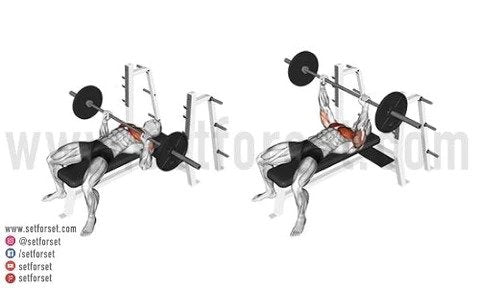
The unique barbell bench press, primarily targeting the chest, shoulders, and triceps, the flat bench is a crucial component of strength programs. It offers the advantage of allowing heavy lifting and a broad range of motion.
The flat bench press also holds a pivotal role in weightlifting, bodybuilding, and powerlifting, serving as one in every of the essential compound exercises. In competitive powerlifting, it is an element of the celebrated “Big Three” together with squats and deadlifts, symbolizing comprehensive total body strength.
do it:
- Lie on a flat bench and reach as much as grab the bar barely wider than shoulder-width apart. As you lower the bar, your forearms needs to be vertical.
- Be certain that your feet are anchored into the ground, lift the bar off the power rack, and center it above your chest.
- Bring the bar slowly right down to tap your shirt, after which exhale and push the bar as much as the starting position.
For more on properly do the flat bench, take a look at our article on the Barbell Bench Press Grip 101: Standard, Wide, Close, And Reverse.
2) Close Grip Bench Press:
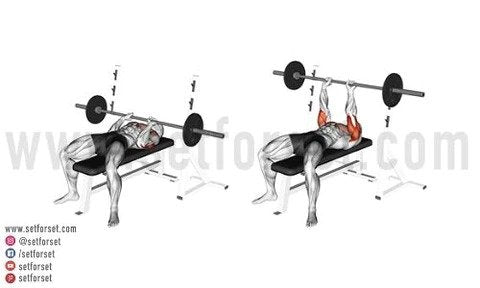
The close grip bench press is a variation of the classic bench press. Because the name suggests, your hands are simply positioned closer together, but this small change has a major impact on the muscles worked.
Despite the altered grip, it stays an elite compound exercise for the upper body and still allows for heavier weights. The closer hand placement shifts the main focus in various upper body muscles, including the triceps, so this variation is usually used for strengthening the lockout portion of your bench press. It is also great for athletes, providing a sport-specific transfer to things like football, basketball, rugby, and more.
Strong triceps are vital not just for aesthetics but additionally for improving performance in pushing exercises just like the bench press. Don’t let weak triceps hinder your bench press progress.
do it:
- Lie on a flat bench and grab the bar together with your hands shoulder-width apart.
- Lift the bar off the rack and center it above your chest.
- Lower the bar to your lower sternum, and ensure your elbows are near your body for your entire movement.
- Exhale and press the bar up, ensuring you utilize the triceps to lock out the arms at the highest.
3) Incline Bench Press:

The incline barbell bench press is performed at a 30-45˚ angle. It emphasizes the shoulders and upper chest, specifically targeting the clavicular head of the pectoralis major, while still engaging the triceps to an analogous extent as a flat bench press.
This movement will be done with a barbell, dumbbells, and even kettlebells, but for simplicity, we’ll deal with the barbell incline press.
do it:
- Lie down on an incline bench set to 45 degrees or under and reach as much as grab the bar barely wider than shoulder-width apart.
- Be certain that your feet are anchored into the ground, lift the bar off the rack, and center it above your chest.
- Bring the bar slowly right down to tap your shirt, after which exhale and push the bar as much as the starting position.
4) Flat Dumbbell Bench Press:

Much like the flat barbell bench, the dumbbell bench press targets the chest, shoulders, and triceps.
Nevertheless, using dumbbells allows for a rather different range of motion and elbow position, as your arms are free to maneuver and press individually. Further, this variation challenges each arm to work individually, highlighting weak points and offering a novel challenge to the muscles with the identical weight.
do it:
- Grab a pair of dumbbells and sit down on a flat bench. Use your knees to assist kick up the dumbbells as you press them over your chest and lay back on the bench.
- Keep your back flat on the bench and lower the dumbbells like you might be holding a bar until your arms are at 90-degree angles and according to your shoulders.
- Exhale and press the weights back overhead.
5) Cable Flies:
While most chest exercises involve pushing movements where the burden is moved away from the chest, the cable fly exercise stands out by offering resistance each in the course of the pushing (concentric) and returning (eccentric) phases of the movement.
It is a highly effective exercise for chest muscle development since it maintains consistent tension throughout your entire range of motion. Subsequently, it’s an incredible addition to any bench press program.
do it:
- Set the cables at the very best setting and pick an appropriate weight.
- Grab the cables and step away from the towers to extend tension. Lean your body forward barely.
- With a slight bend in your arms and palms facing one another, bring your hands down towards the bottom as if hugging a beach ball.
- Pause at the underside and slowly resist on the way in which back as much as feel the stretch within the chest.
6) Close Grip Push-Ups:
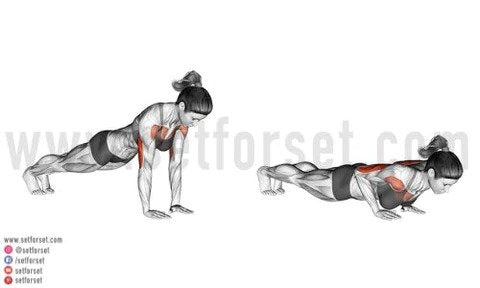
Just like the close grip bench press, this push-up variation requires bringing the hands closer together, altering the upper body joint angles to focus on the triceps and shoulder muscles. Nevertheless, unlike other pressing variations we have covered, the close-grip push up is a closed chain exercise.
Closed-chain movements lock your extremities in place while the remainder of your body moves, equivalent to what occurs with a squat, pull ups, or any push-up variation. As such, they often challenge your entire core, and are especially helpful to groove proximal joint function. When done accurately, these push-ups can improve the health of your shoulder blades, chisel your core, and increase tricep pressing strength.
do it:
- Get into the plank position in your hands. Your hands needs to be closer than shoulder width apart and will be as close as making a diamond together with your hands.
- Slowly lower yourself down until your chest almost touches the ground, and ensure your arms are tucked into your sides.
- Press up and repeat.
7) Explosive Push-Ups:
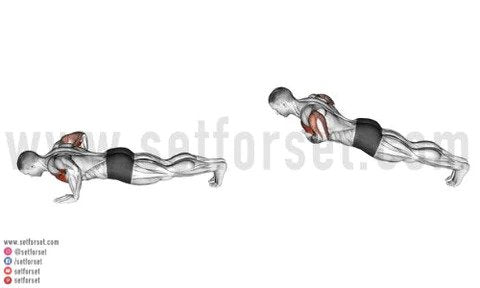
Amongst the assorted push-up variations, the explosive push-up, also often called the plyo push-up, is essentially the most difficult. This plyometric exercise is a ballistic movement designed to reinforce your explosive power and strength, even with light weights.
The dynamic contractions involved on this exercise provide unique muscle stress, contributing to increased muscle growth. Add these into your bench press program to enhance power for sports, gain explosive pressing power, or simply to provide yourself a latest challenge.
do it:
- Arrange in a normal high plank with hands just outside shoulder width apart like a bench press arrange.
- Lower yourself within the push-up until your chest almost touches the bottom.
- From there, drive your hands into the bottom and explode up as fast as possible while releasing your hands to get your upper body as far off the bottom as possible.
- Let your hands softly land back on the ground as you absorb this force and immediately lower down into the following rep without pausing.
8) Weighted Dips:
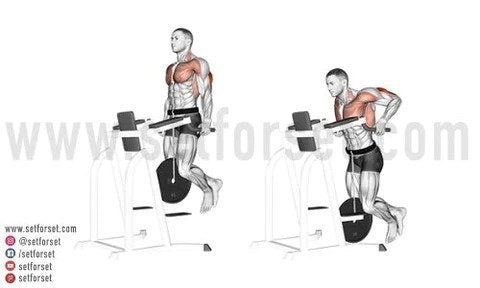
Traditional dips involve lowering your body downward while your hands grip two parallel bars, and your feet are off the bottom. Weighted dips, then again, involve adding extra resistance to extend the exercise’s intensity.
Essentially the most common method is using a dip belt, which consists of a soft waist strap with a series and metal loop for attaching weight plates. Alternatively, in case you do not have a dip belt, you need to use your feet to carry onto a dumbbell, which is a more difficult but effective workaround.
do it:
- Attach a dip belt with a series around your waist and add the suitable weight.
- Grab the parallel bars and extend your arms, so that they are straight, and also you hover between them.
- Lean your upper body forward to not more than a 45-degree angle. Begin to lower down until your arms are at a 90-degree angle.
- Exhale and press back to the starting position without letting your legs swing.
9) Dumbbell Pullovers:
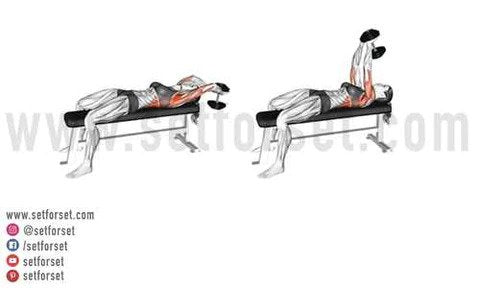
The dumbbell pullover, typically performed on a weight bench, offers substantial upper body advantages by targeting the chest and lats. As such, it’s grow to be popular amongst bodybuilders for its dual chest and back benefits.
Importantly, minor form adjustments can shift the main focus from the back to the chest. The lying dumbbell pullover is a flexible exercise for each chest and lat development, making it a beneficial addition to a bench press routine.
do it:
- Grab a dumbbell and begin lying perpendicular on a bench with only your upper back and shoulders across the bench. Place your feet on the ground and lift your hips until they’re barely lower than the bench height.
- Grab the upper head of the dumbbell and hold it with each hands while straightening your arms, taking it over your chest.
- Keeping your arms straight, lower the burden in an arc behind your head until it’s according to your body. Be certain that to maintain your core engaged and back flat on the bench.
- Slowly bring the dumbbell back to the starting position, keeping your arms prolonged.
Muscles Worked In A Bench Press Program
Most individuals start training the bench press to grow a much bigger chest. This exercise works your pecs through a wide array of motion and sends them right into a deep stretch on the very bottom of the rep. Chest strength is the limiting factor at this portion of the lift.
The bench press can also be great to your shoulders and, mainly, your anterior deltoids. These shoulder muscles help your chest press the burden up. This is usually an issue for people as they struggle to activate their chest and find yourself overworking their anterior delts. Bench press also works your triceps, as they’re an important muscle for the lockout portion of the lift. The close-grip bench press is a unbelievable option for assisting this muscle group.
The chest, delts, and triceps are the show’s stars with regards to the bench press, but another muscles are also involved. You wish strong trapezius and lattisimus dorsi muscles so your back can handle the burden as you lower it. These muscle groups work synergistically, so do not forget in case you want an enormous bench, you wish an enormous, strong back. Consider the back muscles because the breaks that decelerate your sports automotive, so training them is vital to your workout routine.
Advantages Of A Stronger Bench Press
Getting a much bigger bench press is not just about impressing social media or winning powerlifting comps, although those are great reasons to achieve this. Listed below are some more advantages of a stronger bench:
- Increased Upper Body Strength And Size: To get stronger, you should construct more muscle. The bench press does a superb job of killing two birds with one stone here. Not only will this newfound strength transfer to other upper body exercises, but you may even be brimming with confidence whenever you see all that muscle you’ve gotten packed on within the mirror. You’ll be able to expect greater pecs, shoulders, and triceps. This muscle gain will increase force production and supply more cushion for joints.
- Increased Joint Stability: The final word test of stability is absolute strength. Your body must work extremely hard to stabilize when lifting as heavy as possible. By increasing the burden you’ll be able to lift, you might be increasing your body stability and certain stopping injuries in the long run. You’ll get stronger in case you can stabilize your entire body and make this a full-body lift.
- Stronger Bones: Any time you utilize a weight-bearing exercise, you force your body to carry more weight or pressure your bones. The more exercises you do and the heavier the load you utilize, the more your bones can be forced to create latest bone mass to handle it. Larger and stronger bones are especially coveted as you become older, and check out to fight osteoporosis as you age.
- Bragging Rights: Let’s be honest. Talking about your gym triumphs with anyone willing to listen feels good. The following time someone asks how much you bench, you may be excited to share your latest record. If you’ve gotten been lifting for some time, PRs are few and much between, which is why using a selected bench press program is crucial.
Programming Suggestions For Improving Your Bench Press
In the event you are latest to bench pressing, 10-12 sets of chest training per week needs to be loads of bench press volume. Nevertheless, in case you are in an advanced stage of coaching, you’ll likely hit a plateau and wish so as to add more to your training program.
Aim for around 16-20 sets of chest training per week. We discover it best to separate this over two sessions so that you hit the muscle group twice per week.
Be certain that you prioritize the bench press and use 60-95% of your one rep max for many sets. Remember to coach the back muscles as well in a training session! Be certain that to provide yourself at the very least 48 hours between sessions to get well and avoid injury.

FAQs
Let’s answer some more of your ceaselessly asked questions on benching.
What’s the very best bench press program?
The most effective program prioritizes the bench press while using progressive overload and proper assistance exercises to focus on your weak points. This system I just laid out today is a unbelievable option.
Is 5×5 for bench press effective?
5×5 training programs will be highly effective so long as you might be progressing from week to week.
Is 225 bench press strong?
The primary milestone for bench pressing is benching your body weight. Most individuals weigh lower than 225, so that is an incredible start line to aim for.
How do I get my bench to 315?
In the event you are within the high 200s, you might be knocking on the door for a 315 bench. Follow a bench press program that focuses on percentage and progressive overload, in addition to assistance exercises for weak points.
What workouts help improve bench?
All upper body sessions have some carryover to bench press, however the major workouts are bench pressing, assistance exercises for the chest, shoulders, and triceps, and constructing a powerful back.
Bench Press Strength Program: Final Thoughts
Great bench press programs provide a strategic, time-bound approach designed to progressively overload your muscles each week. Furthermore, an efficient program targets your weak points, specializing in strengthening specific areas to assist you to overcome essentially the most difficult phase of the lift.
In contrast to the best scenario of adding 5 kilos every week to our lifts indefinitely, the truth is that strength gains grow to be more elusive over time. A powerful bench press program offers a structured roadmap for achieving impressive numbers and hitting your goal, especially as you advance in your lifting journey.
To learn more about bench press training, read our Bench Press Guide: How To, Advantages, Muscles Worked & Best Variations.







